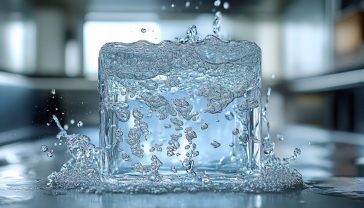Granite Worktops and Radioactivity: A Sensible British Guide to a Curious Kitchen Question
A comprehensive guide for British homeowners on whether granite worktops are radioactive, putting the negligible risks into sensible perspective.

This post may contain affiliate links. If you make a purchase through these links, we may earn a commission at no additional cost to you.
So, you’re finally doing it. After months of circling catalogues, staring at samples, and drinking far too much tea while pondering the perfect shade of grey, you’ve decided on a granite worktop. It’s a classic choice. Solid, beautiful, each slab a unique piece of geological art millions of years in the making. It’s going to look stunning.
But then, you hear a whisper. Maybe from a well-meaning relative, a random comment on a Mumsnet forum, or a sensational headline you half-read online. “Did you know,” the whisper says, “that granite can be… radioactive?”
Suddenly, your dream kitchen feels a little less dreamy. Visions of glowing green counters and Geiger counters crackling over your morning toast spring to mind. Is your beautiful new worktop, the centrepiece of your home, secretly a low-level nuclear reactor? Is it silently zapping you and your family while you chop carrots for the Sunday roast?
It’s a startling thought, isn’t it?
Well, take a deep breath and put the kettle on. Let’s have a calm, sensible chat about it. The short answer is: yes, granite worktops are technically radioactive. But the much, much more important answer is that, in almost every case, it’s about as dangerous as eating a banana.
This guide is here to walk you through the science, separate the facts from the fear, and give you the confidence to love your granite worktop without a hint of worry. We’ll explore what radiation actually is, why a natural stone like granite has it, and how it compares to the everyday radiation we live with all the time here in the UK.
Part 1: What on Earth is Radiation, Anyway?
Before we can talk about granite, we need to get our heads around the word ‘radiation’. It sounds scary, conjuring images of sci-fi films and hazard symbols. But in reality, radiation is a completely natural part of our world.
Imagine you’re making popcorn. You have a pan full of kernels. As they heat up, they become unstable and, one by one, they ‘pop’. When they pop, they release a little burst of energy. You can hear it, you can feel the pan shake, and you can smell it.
Atoms, the tiny building blocks of everything, can be a bit like those popcorn kernels. Some atoms are perfectly stable and happy to sit there forever. Others are ‘unstable’. These unstable atoms are called radioactive isotopes. To become stable, they have to get rid of some excess energy, and they do this by ‘popping’—or, in scientific terms, decaying.
When a radioactive atom decays, it shoots out tiny, high-energy particles or waves. This emission of energy is radiation.
There are three main types, which scientists cleverly named after the first three letters of the Greek alphabet:
- Alpha Particles: Think of these as little cannonballs. They’re relatively big and heavy. They can’t travel far and are incredibly easy to stop. A single sheet of paper, or even the outer layer of your skin, is more than enough to block them. They are only a risk if you were to swallow or inhale the substance that’s emitting them.
- Beta Particles: These are more like tiny bullets—smaller, lighter, and faster than alpha particles. They can travel a bit further and can get through paper, but they are easily stopped by a thin sheet of aluminium or a pane of glass.
- Gamma Rays: These aren’t particles at all; they’re high-energy waves, like super-powered X-rays. They travel at the speed of light and are much more penetrating. It takes thick lead or very dense concrete to stop them.
The crucial thing to remember is that we are surrounded by this stuff all the time. It’s in the air we breathe, the food we eat, the ground beneath our feet, and even inside our own bodies. This constant, low-level exposure is called background radiation, and it’s completely normal and unavoidable.
Part 2: A Rock’s Story – Why Is Granite Radioactive?
So, how does this link to that lovely slab of granite you’ve got your eye on? To answer that, we need a quick geology lesson.
Granite is an igneous rock. That’s a fancy way of saying it was born from fire. It formed deep within the Earth’s crust between 750 million and 3 billion years ago. It started as a mass of molten rock called magma. This magma cooled down incredibly slowly over millions of years, allowing large, beautiful crystals of different minerals to grow. It’s these interlocking crystals—mostly quartz, feldspar, and mica—that give granite its distinctive speckled appearance and robust strength.
Now, when this magma was bubbling away, it was a bit like a cosmic soup. It contained all sorts of elements that were present in the Earth’s crust. Among these were tiny traces of naturally occurring radioactive elements, chiefly uranium and thorium. Also present was a radioactive version (an isotope) of a very common element, potassium-40.
As the magma cooled and solidified into granite, these radioactive elements were locked into the crystalline structure of the stone. They became a part of the rock itself.
The ‘Hot’ Rocks: Uranium, Thorium, and Potassium-40
These three are the main culprits behind granite’s radioactivity. Like those popcorn kernels, they are unstable. They decay over billions of years, slowly transforming into other, more stable elements in a process called a ‘decay chain’.
- Uranium-238 and Thorium-232: These are the big ones. They have incredibly long ‘half-lives’ (the time it takes for half of their atoms to decay), which are longer than the age of the Earth itself. As they decay, they transform into a series of other radioactive elements, including radium, before eventually becoming stable lead. Along the way, they release alpha, beta, and gamma radiation.
- Potassium-40: This is a radioactive isotope of the potassium you find in bananas and avocados. It’s far less radioactive than uranium or thorium but is much more common in the Earth’s crust, so it contributes to the overall background radiation from rocks.
Because granite is a natural product, the concentration of these elements varies wildly from one slab to another. A piece of granite quarried in Brazil will have a different mineral makeup from one quarried in Scotland or India. Even within the same quarry, levels can differ. This is why you might see such a beautiful variety of colours and patterns—from deep blacks and blues to vibrant reds and exotic veined whites. Generally, lighter-coloured granites tend to have slightly lower concentrations, while some of the more colourful, veined, or reddish granites can have higher levels, as the elements causing those colours are sometimes associated with uranium and thorium.
Part 3: Putting It in Perspective – Is Your Kitchen a Mini-Chernobyl?
Okay, so granite contains radioactive elements that release radiation. That’s a fact. But this is where context is everything. The dose makes the poison, as they say. The critical question isn’t “is it radioactive?” but “how radioactive is it, and does it actually pose a risk?”
Measuring the Unseen
Radiation dose is measured in a unit called the sievert (Sv). Because the doses we encounter in daily life are tiny, we usually talk in millisieverts (mSv), which is one-thousandth of a sievert.
In the UK, the average person receives a total radiation dose of about 2.7 mSv per year from all sources of background radiation combined. Let’s break down where that comes from:
- Radon Gas (~1.3 mSv): This is the single biggest contributor, making up about half of our annual dose. Radon is a radioactive gas produced during the decay chain of uranium in the ground. It can seep into our homes from the soil, especially in granite-rich areas like Cornwall and Aberdeenshire.
- Medical Procedures (~0.4 mSv): Things like X-rays and CT scans contribute to our dose.
- Ground and Buildings (~0.35 mSv): The natural radioactivity in the soil and building materials like bricks and concrete.
- Food and Drink (~0.3 mSv): Yes, your food is radioactive! Bananas, Brazil nuts, carrots, and potatoes are all naturally radioactive because they contain potassium-40. Even beer is.
- Cosmic Rays (~0.25 mSv): High-energy particles from the sun and outer space constantly shower down on Earth.
So, where does a granite worktop fit into this picture?
Numerous scientific studies have been conducted worldwide to answer this exact question. Organisations like Public Health England (now the UK Health Security Agency, UKHSA), the US Environmental Protection Agency (EPA), and health bodies across Europe have all examined granite worktops.
Their conclusions are remarkably consistent.
The radiation emitted from even the most ‘active’ granite worktops is incredibly low. A typical granite worktop might increase the radiation dose to someone in the kitchen by about 0.005 to 0.012 mSv per year.
Let’s be clear about what that number means. It’s a tiny fraction of your total annual background dose.
The Great British Radiation Comparison
To really understand how small that dose is, let’s compare it to some other everyday activities and sources:
- Eating one banana: Gives you a dose of about 0.0001 mSv (from potassium-40). You would need to eat about 50 bananas to get the same dose as spending a year with your granite worktop.
- A flight from London to Spain: About 0.01 mSv. The dose from one holiday flight is roughly equivalent to an entire year of exposure from your worktop. This is because you’re higher up with less atmosphere to shield you from cosmic rays.
- A chest X-ray: About 0.02 mSv. One X-ray is worth about two to four years of granite worktop exposure.
- Living in Cornwall: Due to the granite bedrock, residents of Cornwall receive, on average, a much higher background radiation dose than the rest of the UK, around 7.8 mSv per year—nearly three times the national average.
The verdict is clear: the radiation dose from a granite worktop is negligible. It is buried deep in the noise of normal, everyday background radiation that we are all constantly exposed to. It is far, far below any level that has ever been shown to have a discernible effect on human health.
What About Radon Gas from Worktops?
This is a slightly more nuanced part of the conversation. As the uranium in granite decays, one of the elements it turns into is radon, a gas. Some people worry that their worktop could be releasing radon gas into their kitchen.
Again, studies have looked at this in detail. They found that while granite worktops do release some radon, the amount is minuscule. The primary source of radon in the home is, and always will be, the soil and rock underneath your house.
A well-ventilated kitchen (e.g., one with an extractor fan you use when cooking, or a window you open now and then) will easily disperse the tiny amount of radon from a worktop, preventing it from ever building up to a level worth thinking about. If you live in a high-radon area, you should be taking steps to mitigate radon from the ground, but your worktop is not the source to worry about.
Part 4: What the Experts Say – Busting the Myths
You don’t have to take our word for it. Let’s look at what independent, official bodies have to say.
The UK Health Security Agency (UKHSA) is the government body responsible for public health protection, including radiation. Their guidance is unequivocal. They state that the levels of radiation from materials like granite are very low and do not pose a risk to the public. They have assessed building materials extensively and concluded that granite used in homes is not a cause for concern.
Internationally, the consensus is the same. The Health Physics Society in the US states, “While granite is radioactive, the dose that you will receive from your granite countertops is well below the level that is considered to be of concern.”
So why does this myth persist?
Often, it’s driven by a few things:
- Sensationalist Media: Headlines like “Killer Kitchens!” grab attention, even if the article itself reveals the risk is tiny.
- Competitor Marketing: Some companies selling man-made worktop materials (like quartz or solid surfaces) have been known to use the ‘radiation’ angle to create fear, uncertainty, and doubt about a natural competitor.
- Genuine Misunderstanding: The science is complex. It’s easy for the scary-sounding word ‘radiation’ to be taken out of context. Someone might use a Geiger counter on a piece of granite, see the needle jump, and post a panicked video on YouTube without understanding that the reading is trivial compared to normal background levels.
Part 5: Practical Advice for the Prudent Homeowner
Even after hearing all this, you might still have a lingering “what if?” in your mind. What if you get that one-in-a-billion slab that’s unusually radioactive? Let’s address those final concerns.
Choosing Your Granite
As we mentioned, the radioactivity of granite varies. If you are extremely cautious, you could stick to more common, less exotic, and lighter-coloured granites, which statistically tend to have lower levels of radioactive minerals.
However, even the most exotic, red, or heavily veined granites that have been tested still fall well within the safe range. There has never been a commercially sold granite worktop found to emit radiation at a level considered dangerous. The industry has a vested interest in safety, and quarries are aware of these issues.
Ultimately, you should choose the granite you love the look of. The radiological difference between them is purely academic, not a matter of practical safety.
Should You Test Your Worktop?
In a word: no. It’s not necessary. The consensus among health physicists and government bodies is that granite worktops are safe. Spending money on a professional radiological test or buying a Geiger counter would be like hiring a food scientist to test your bananas for potassium-40. It’s a solution in search of a problem.
If you live in a part of the country with a known radon problem (you can check with the UK Radon Association), you should absolutely consider testing your home for radon gas seeping from the ground. This is a genuine, recognised health risk that can be easily managed with simple measures like installing a radon sump. But this has nothing to do with your choice of kitchen worktop.
Conclusion: A Storm in a Teacup?
Let’s circle back to where we started: that nagging worry about your beautiful new kitchen.
Yes, granite is radioactive. But so is the brick your house is made of, the soil in your garden, the potato in your cupboard, and even you. Radioactivity is a natural, unavoidable feature of the planet we live on.
The radiation coming from a granite worktop is a tiny, insignificant drop in the vast ocean of natural background radiation we experience every day. It’s a scientifically documented non-issue. The risk it poses to your health is so small that it is completely undetectable, falling far below the risk posed by crossing the road, eating a bacon butty, or taking a flight for your summer holiday.
So go ahead and choose that stunning slab of deep blue, speckled white, or earthy red granite. Install it, admire it, and enjoy it. Let it be the heart of your home, a place for family meals, late-night chats, and countless cups of tea.
It’s a piece of ancient, beautiful, and powerful geology. And it’s perfectly safe.
Further Reading
For those who wish to delve deeper into the data and official statements, here are some highly respected resources:
- UK Health Security Agency (UKHSA) – Radiation: The official source for information on radiation protection for the British public. https://www.gov.uk/government/organisations/uk-health-security-agency
- UK Radon Association: For information on radon gas in UK homes, including maps and mitigation advice. https://www.radonassociation.co.uk/
- World Health Organization (WHO) – Ionizing Radiation: Global information on radiation sources and health effects. https://www.who.int/news-room/fact-sheets/detail/ionizing-radiation
- The Marble Institute of America – Natural Stone & Radiation: A collection of studies and resources addressing this topic. https://www.naturalstoneinstitute.org/consumers/radiation/






